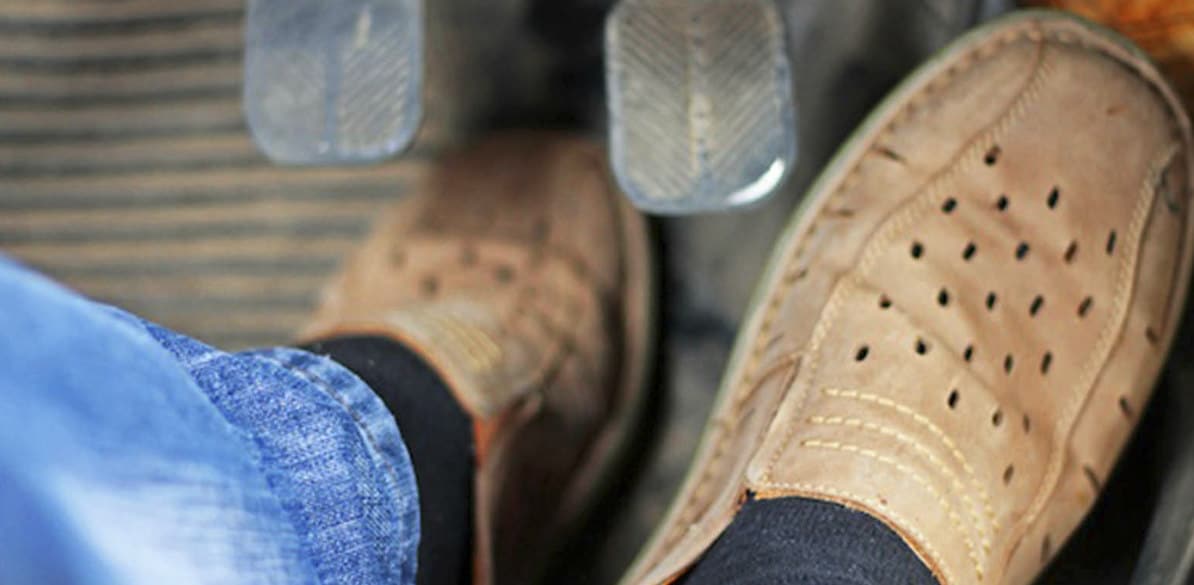Malformed foot and static disorders of the forefoot interfering with driving

Malformed foot
Malformations of the fingers, both ectrodactylism, or absence of a toe, and polydactyly, do not usually cause problems for driving.
Finger deviations only affect driving when they are associated with painful heloma that both for its effect and for the forced pain relief position, can be determinant in the use of car pedals.The basic treatment is delamination of the heloma, and if appropriate, surgical correction of digital deviation.
Foot malformations can be associated with finger or leg malformations.
- Congenital amputations: there are many types and they cause problems of functional type with support disorders. At time, foot prostheses make up for the absent elements and enhance load distribution.
- Congenital synostosis: it usually occurs in the tarsus and the treatment includes orthopedic insoles, physiotherapy, and immobilization based on the symptoms.In adults with osteoarthritis, double astragalocalcanean and calcaneonavicular arthrodesis are usually the choice.
- Skeletal hypoplasias: in bone aplasias, the feet, regardless of them being normal or not, are often implicated in the treatment.Crab claw foot is structured as two radios separated without possible satisfactory surgical repair.Congenital shortening of one or more metatarsals is associated with dorsal retraction of the affected finger, and is tolerated well if the plantar callosity usually appearing below overloaded heads of metatarsals, due to the lack of load in the short metatarsal, is solved.
Tips
- Toe deviations associated with severe pain hinder the appropriate support to pedals and therefore make difficult the adequate control of the car when driving.
- The specialist should advise against driving with a minimum suspect of lack of adequate support in the pedals.
- The patient may not drive after surgical correction, until foot recovery is complete, and always in the absence of bandages or immobilizations.
Static forefoot disorders
The static foot is not always pathological but usually progresses to mechanical and frequently symptomatic problems, with progressive burning pain, deformation, cramps, drawbacks when putting on shoes and hyperkeratosis.
Mechanical talalgias are related to repeated microinjuries.
Obesity, orthostatism, venous insufficiency, shortening of the Achilles tendon, use of ankle-eroding footwear and prolonged walks enhance the appearance of mechanical talalgias.
Posterior talalgia:
Achilles tenoperiostitis occurs with mechanical pain in the posteroinferior area of the heel, that can be associated with bursitis in the Achilles area from friction of the footwear.
This fibrous swelling can become fistulized or overinfected, and in this situation, if walking with footwear is painful, the driver can become exhausted with driving involving continuous flexo-extensions of the ankle.
Therefore, a footwear with too hard or wide buttress, will increase the friction in the area and the burning pain it causes.
The presence of Haglund’s exostosis as bone agent pressing on the area will worsen the clinical condition.
Conservative treatment combines recommendation for footwear, and use of insoles or orthesis, correcting the heel position and cushioning against local pressure.
Surgical treatment is the alternative option for selected cases.
Plantar talalgia:
Pain is always of mechanical origin, and it is frequently difficult to identify the causal agent.
It is the case of atrophy of the adipose pack, the rupture of the plantar fascia, painful heel syndrome, plantar fascitis and tendinitis of the long flexor of the hallux, tendinitis of the long flexor of the fingers or of both.
Also, nerve entrapment in tarsal tunnel syndrome or of the first branch of the lateral plantar nerve, stress fracture of the calcaneum or a tumor.
Most plantar talalgias can be treated satisfactorily with conservative procedures, particularly if the treatment is started early with pain progression.
When the accurate diagnosis is obtained, surgical treatment on an ambulatory basis can provide an excellent result and, in two or three weeks, the foot will be able to drive.
Tips
- Congenital amputations: they do not affect significantly driving, except for the complete absence of the foot that requires adapting the car to drive.
- Congenital synostosis:
- This surgical technique requires a prolonged post-operative recovery during which the patient cannot drive.
- Subsequently, if the surgical outcome is the expected one, although the midfoot is immobilized, driving is permitted without restrictions, since it does not interfere with adequate pedal support.
- Skeletal hypoplasias:
- For driving, it will only be problem if plantar heloma is in a painful phase that impedes the adequate control of pedals.
- When the shortening affects the first metatarsal, it causes an overload in the metatarsal area, that is managed with orthopedic insoles that improve support in the pedals providing a safe driving.
- Shortening of the metatarsal associated with severe metatarsal pain prevents an adequate support on pedals and therefore the adequate control of the car when driving.
- Orthopedic or surgical treatment will enable the driver to adequately support the feet without fear of pain and without risk when accelerating or stopping.
- Static forefoot disorders:
- If the condition is very painful, when driving forces to the sudden use of the foot on the pedals, a pain relief footstep can be made which is not as efficient as it would be expected, with the attendant risk of crash.
- In these cases we should advise against driving until conservative or surgical causal treatment permits support without pain.
- With bandages and immobilizations, the patient cannot drive.
- The surgical techniques require a more or less prolonged post-operative recovery period during which the patient cannot drive.
- The specialist will indicate the time of complete recovery without sequelae, that will permit safe, convenient driving.
